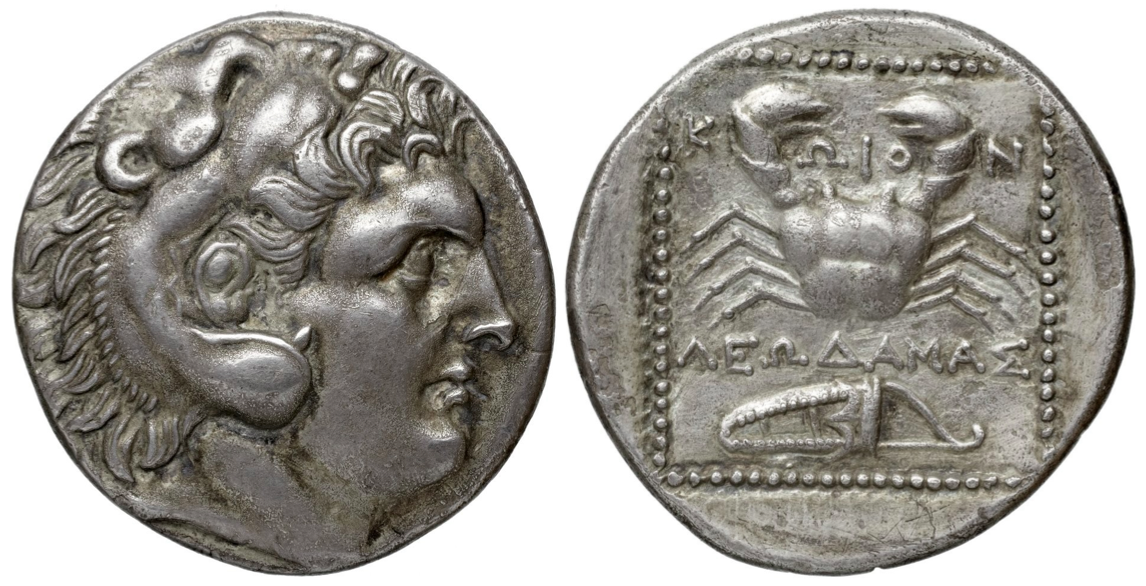Cos, silver, tetradrachms (Heracles/crab) (280-250 BCE)
From SILVER
280 BCE - 250 BCE Silver 4,995 kg
Description
| ObverseInscription or printing placed on the obverse.: | Head of Heracles right, wearing Nemean lion skin headdress. |
| ReverseInscription or printing placed on the reverse.: | ΚΩΙΟΝ (Greek).Crab. In the field, magistrate name and bowcase. All within incuse square with square of dots. |
Mint and issuing power
| MintIdentifies the place of manufacture or issue of a numismatic object.: | Cos | Ancient regionAncient region.: | Caria (islands) | Modern countryModern country: Greece | AuthorityIdentifies the issuing power. The authority can be "pretended" when the name or the portrait of X is on the coin but he/she was not the issuing power. It can also be "uncertain" when there is no mention of X on the coin but he/she was the issuing power according to the historical sources: |
Chronology
| FromIdentifies the initial date in a range assigned in a numismatic context. | 280 BCE | toIdentifies the final date in a range assigned in a numismatic context.. | 250 BCE | PeriodTime period of the numismatic object.: Hellenistic 323-30 BC |
Physical description
| MetalThe physical material (usually metal) from which an object is made.: | Silver |
Median weightMedian of the weights of numismatic objects (in grams). in grams | 15.20 | DenominationTerm indicating the value of a numismatic object. Examples: tetradrachm, chalkous, denarius.: | tetradrachm |
StandardStandard.: |
Image

RQEM_ad_294.png "Paris, BnF, 1966.453.2729 (https" has not been listed as valid URI scheme.[Paris, BnF, 1966.453.2729 (https://gallica.bnf.fr/ark:/12148/btv1b8501671r)]
References
| Die study referencePublication of the study: | Ingvaldsen 20021Ingvaldsen 2002, p. 278-286 (series XIV) | ||
| Coin series referenceReference to coin series study: | |||
| Coin series web referenceCoin series web references: | |||
Obverse dies distribution
| FrequencyFrequency of specimen in distribution. ᵖ | Number of obversesNumber of obverse dies. ᵖ (o) | % (o) | Number of coinsNumber of coins. (n) | % (n) | Die nameName(s) of the die(s). |
| 1 | 4 | 25 | 4 | 2.82 | 3, 4, 7, 9 |
| 3 | 1 | 6.25 | 3 | 2.11 | 6 |
| 5 | 2 | 12.5 | 10 | 7.04 | 10, 11 |
| 6 | 1 | 6.25 | 6 | 4.23 | 2 |
| 7 | 1 | 6.25 | 7 | 4.93 | 8 |
| 8 | 1 | 6.25 | 8 | 5.63 | 12 |
| 12 | 2 | 12.5 | 24 | 16.9 | 5, 16 |
| 14 | 1 | 6.25 | 14 | 9.86 | 13 |
| 17 | 1 | 6.25 | 17 | 11.97 | 15 |
| 20 | 1 | 6.25 | 20 | 14.08 | 14 |
| 29 | 1 | 6.25 | 29 | 20.42 | 1 |
| Total | 16 of 16 | 100 | 142 of 142 | 99.99 |
Reverse dies distribution
no distribution is available
Quantification
| Number of obversesNumber of obverse dies. ᵖ (o) | 16 | Number of singletons (o1)The number of singleton coins. ᵖ | 4 |
| Number of reverse diesNumber of reverse dies. (r) | 58 | Number of coinsNumber of coins. (n) | 142 |
| Coins per obverse dieNumber of coins per obverse die. (n/o) | 8.88 | Coins per reverse dieNumber of coins per reverse die. (n/r) | 2.45 |
| Reverse per obverse ratioRatio of obverse dies divided by reverse dies. (r/o) | 3.63 | Percentage of singletons (o1)number of coins (n) divided by the number of singletons (o1) ᵖ | 25 % |
| Original number of dies (O) (Carter 1983 formula)The estimation of the number of coins according to Carter 1983 ᵖ | 16.43 | Coins struck if 20,000 as average productivity per dieCoins made if the average productivity for obverses (according to Carter) is 20,000. ᵖ | 328,600 |
| Original number of dies (O) (Esty 2011 formula)The estimation of the number of coins according to the singleton formula in Esty 2011 ᵖ (O) | 18.03 | Survival rate if 20,000 as average productivity per dieSurvival rate if average productivity is 20,000. ᵖ | 0.00043 |
| Coverage (o = % of O) (Esty 1984 formula)Esty 1984 - coverage (% of O) ᵖ (o = % of O) | 97.18% | Die productivity if survival rate 1/2,000Average productivity if survival rate is 1/2,000. ᵖ | 17,285.45 |
| Weight of silver (in kg) if 20,000 coins per die (O = Carter formula)Carter 1983 * Median weight * 20000 (*10 if gold or electrum) ᵖ | 4,995 kg <br /> 4,995 kg | Die productivity if survival rate 1/5,000Average productivity if survival rate is 1/5,000. ᵖ | 43,213.63 |
Remarks
References
- ^ Ingvaldsen, Håkon (2002), Cos. Coinage and Society. The chronology and function of a city-state coinage in the Classical and Hellenistic period, c. 390 - c. 170 BC, unpublished doctoral dissertation, Oslo University.